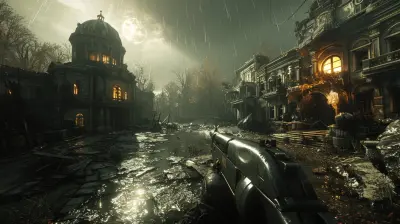Adapting Literary Devices for Interactive Storytelling in Video Games
7 June 2025
Have you ever cried while playing a video game? Or maybe felt goosebumps when that one twist hit you out of nowhere? That right there—that emotional punch—is storytelling at its finest. And just like in books or movies, it’s the clever use of literary devices that brings those game narratives to life. But here’s the twist: games are interactive. That means writers need to think creatively when adapting traditional literary techniques to a medium where players call some of the shots.
Sounds tricky? It is. But it’s also what makes storytelling in video games so ridiculously exciting. So grab a snack, get comfy, and let’s dive into how literary devices are being reimagined for the gaming world.
What Are Literary Devices, Anyway?
Let’s back up a bit. Literary devices are the tools writers use to craft their stories. Think foreshadowing, symbolism, irony, metaphors—you’ve probably come across tons of them in your high school English class. In books, these devices help build suspense, deepen themes, flesh out characters, or just straight-up mess with your head in all the best ways.In video games, it’s not just about telling a story… it’s about living it. So developers and writers have to tweak these devices, making them work within an environment where players are actively shaping what happens next.
Why Literary Devices Matter in Games
Before we dive deeper, let’s answer the obvious question: why should anyone care about literary devices in video games?Simple—because they’re the secret sauce. Without them, a game’s story can feel flat, predictable, or totally forgettable. With them, you get unforgettable moments like Bioshock’s twist, The Last of Us’ emotional depth, or the haunting atmosphere of Inside.
Games can be experiences, not just entertainment. Literary techniques give writers tools to create those experiences.
Player Agency: The Game-Changer
Here’s where it gets tricky. In books and movies, you control the narrative. The audience just follows along. In games, the player can influence the story. That changes everything.Imagine trying to build suspense with foreshadowing… but the player skipped that cutscene. Or trying to tell a story using flashbacks… but the player can tackle missions out of order. That’s the challenge—and the beauty—of adapting literary techniques for games.
Foreshadowing: Planting Seeds in a Sandbox
You know that feeling when an earlier moment suddenly makes sense hours later? That’s foreshadowing, baby. It’s like planting a tiny seed that blossoms into an “Aha!” moment down the line.In games, it’s used more subtly. Think environmental storytelling—those bits of a world that whisper hints instead of shouting exposition. In Dark Souls, for example, item descriptions and eerie statues often hint at the lore well before it’s explained (if it ever is). That’s foreshadowing minus the cutscenes.
It also pops up in level design, character dialogue, and even music cues. But here's the catch: because players explore at their own pace, writers need to weave these clues into multiple layers so players won’t miss them entirely.
Symbolism: More Than Just Pretty Visuals
Symbolism is all about deeper meaning. That blood-red moon? That shattered mirror? Those aren’t just cool visuals—they’re speaking a language of their own.Games like Journey or Limbo are built almost entirely on symbolic storytelling. The colors, the landscapes, the creatures—they’re all metaphors for things like grief, hope, or fear. It’s minimalism with emotional weight.
In interactive media, symbolism becomes even more powerful because players physically move through it. It’s like walking through a poem.
Flashbacks and Nonlinear Timelines: A Narrative Puzzle
Trying to tell a story out of order is risky in any medium. But in games, it’s often the best way to keep things fresh and flexible. Games like The Witcher 3 or Red Dead Redemption 2 sprinkle in flashbacks to add depth without halting gameplay.Some go full-on nonlinear. Take What Remains of Edith Finch—each mini-story is its own self-contained vignette with a unique style and tone. The result? A narrative that feels like a painting made from 12 different brushes.
The key here is context. In a book, a chapter breaks the fourth wall and says, “Hey, here’s a flashback now.” In games, developers have to signal it visually or through gameplay—like using a washed-out filter, changing music, or shifting the controls.
Irony: When the Game Knows More Than You
There’s nothing like dramatic irony to make a player scream “Nooo!” at their screen. It’s that delicious moment when you know something the characters don’t.In games, the challenge is timing. Since players explore at their own pace, developers have to structure events so those ironic reveals still hit hard—even if the player took a weird detour through the side quests.
A great example? Spec Ops: The Line. It flips the typical military shooter into a critique of violence, and the player’s earlier choices come back in ways that sting. That’s irony turned into emotional gut-punch.
Unreliable Narrators: Messing With Your Mind
Ah, the unreliable narrator—a classic literary twist that turns everything you thought you knew into a lie.Games shine here because they trick you, the player, into believing one version of the story—only to pull the rug out from under your feet. Ever played Bastion or The Stanley Parable? You’re following a voice, thinking it’s guiding you… but it’s actually bending the rules, lying, or even mocking your choices.
The interactivity makes it even more personal. You’re not just watching the unreliable narrator—you’re inside their world, trying to make sense of it yourself.
Metaphor in Mechanics: When Gameplay is the Story
Here’s where games do something no book or movie can. They turn the act of playing into metaphor.Take Celeste, for example. It’s a brutally hard platformer about climbing a mountain. But it’s not just a mountain—it’s a metaphor for anxiety, self-doubt, and mental health. As you struggle to complete each level, you’re literally experiencing what the main character feels.
Gameplay becomes storytelling. That’s next-level literary device adaptation right there.
Character Arcs in Choice-Driven Stories
Character arcs are a staple in all storytelling. But when the player helps shape a character’s journey? That adds a whole new layer.Games like Mass Effect, Detroit: Become Human, and Life is Strange give you control over how characters grow or crumble. Your choices lead to different arcs, different relationships, and wildly different endings.
The challenge? Writers have to build multiple versions of the same character—and make sure they're all believable. That’s like writing three novels layered into one game. No pressure, right?
Immersion Through Voice and Tone
One of the most underrated literary techniques? Tone. It sets the vibe. Is this story dark and gritty? Whimsical and funny? Sarcastic and meta?Voice and tone in games don't just come from dialogue—they’re baked into the art style, the soundtrack, the UI, and even the pacing.
Think of Borderlands with its over-the-top sarcasm or Firewatch’s emotional intimacy driven by just two voices in a walkie-talkie. That’s tone doing its job and pulling you in.
The Unique Power of Interactivity
So here’s the magical thing about games: no other medium puts the audience in the driver’s seat like this. That changes how we tell stories.Every time you swing your sword, make a moral decision, or choose a dialogue option, you're affecting the story—not just watching it unfold. That means literary devices need to work around and with the player's input. They need to be flexible, quietly adapting, and always aware that someone unpredictable is at the wheel.
It’s storytelling with training wheels off—and it’s incredible.
Final Thoughts: Literary Devices Are More Alive Than Ever
Let’s be honest—storytelling in video games is still evolving. But that’s what makes it so exciting. Writers today aren’t just borrowing literary devices from books and films—they’re reengineering them to fit a whole new playground.Games have the unique ability to make us live a metaphor, walk through a mood, or unravel a mystery at our own pace. And when they use literary techniques well? They become unforgettable.
So next time you're playing a story-heavy game, look a little closer. Notice the hints, symbols, ironies, metaphors... they’re everywhere. You’re not just playing a game—you’re living a novel, one decision at a time.
all images in this post were generated using AI tools
Category:
Interactive StorytellingAuthor:

Kaitlyn Pace
Discussion
rate this article
3 comments
Sablethorn Young
Turning pages into play: where narrative meets interactivity for epic storytelling adventures!
June 20, 2025 at 3:18 AM

Kaitlyn Pace
Thank you! I’m excited to explore how blending narrative with interactivity can create immersive experiences in gaming.
Arwenia McFarlane
Let’s push boundaries! Literary devices elevate gaming; it’s time for a storytelling revolution!
June 9, 2025 at 2:33 AM

Kaitlyn Pace
Absolutely! Embracing literary devices can transform gaming narratives, creating deeper emotional connections and enriching player experiences. Let’s innovate together!
Dusk Simon
Who knew literary devices could level up our gaming? Next thing you know, we’ll have Hemingway-style boss fights where you should only get one shot—no pressure! Just remember, if the plot twist is better than your skills, you're probably playing the wrong game. Game on, Shakespeare!
June 8, 2025 at 3:02 AM

Kaitlyn Pace
Thanks for the fun comment! Literary devices can definitely enhance gaming experiences—turning every choice into a narrative twist keeps players engaged. Game on indeed!



